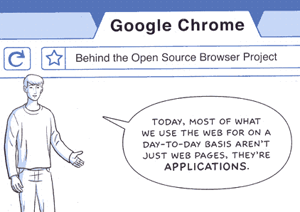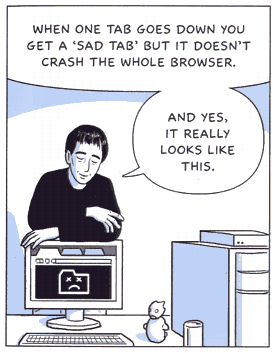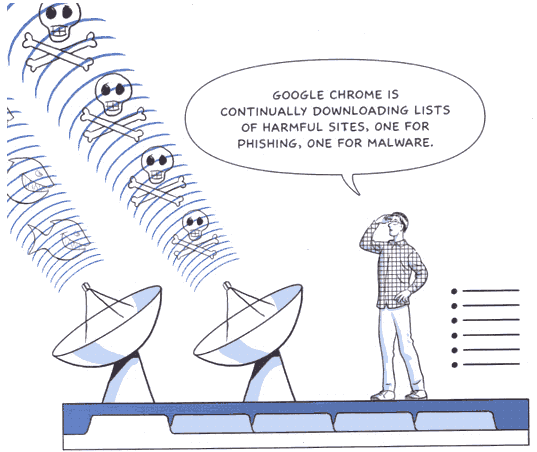
Update: Google has posted on its official blog saying they screwed up by mailing this cartoon out early. A beta version of Chrome will be made available tomorrow in over 100 countries – but, alas, for Windows only to start, with Mac and Linux on the way.
Update 2: It looks like Google has at least semi-launched its Chrome site here. It provides this screenshot of the browser.

Google Blogoscoped has published a lengthy cartoon sent to them by Google and drawn by Scott McCloud that provides the first public details about Google Chrome, an open source browser based on WebKit and powered by Google Gears that has been rumored but never before confirmed.
According to the cartoon (which can be seen in its entirely here – thanks Marshall), the Google Chrome project has already undergone a substantial period of development with engineers working to create a product that’s secure, user friendly, fast, stable, safe, and easily testable. No word yet, however, on when it will be released.
This is a straight shot over the bow of Microsoft, which has tightly integrated its Live Search offering into its dominant Internet Explorer browser (and which, surprise, is in turn tightly integrated into Windows). It also makes for an awkward relationship with Mozilla, whose Firefox browser Google basically funds.
The cartoon breaks down Google Chrome’s features into the following four topics:
Super Tabs and Scalable Testing

Unlike other modern web browsers, which can only run one process at a time, Google Chrome will give each tab its own process. This speeds up overall performance and saves the entire browser from crashing when one tab causes problems.
The multi-process design requires more memory allocation up front but less memory over time as users tend to multitask. It also prevents your computer from slowing down after you browse for an extended period of time and open/close lots of tabs.
Google Chrome also features a task manager that can be used to determine just which tabs and plugins are hogging just how much memory. It’s main purpose is to spot bad actors and close them before they ruin your browsing experience.
Google is leveraging its massive server infrastructure to run automatic performance tests for Chrome. The company is claiming that its Chrome Bot can test the browser on tens of thousands of different webpages within 20-30 minutes of each build. These webpages are chosen on the basis of their popularity, which has already been determined by Google with the data it collects from its search users. When Google started testing Chrome, it only rendered 23% of those pages correctly (no word on how many it gets right as of today now it apparently renders 99% correctly).
Speed: Webkit and V8
Google decided to implement the Webkit rendering engine (also found in Safari and the forthcoming Android mobile platform) because of its speed and simplicity.
To improve the performance of JavaScript processes, Google also decided to build its own JavaScript virtual machine (called V8) from the ground up. The virtual machine leverages the concepts of hidden class transitions, precise garbage collection, and machine code generation to make JavaScript-heavy applications snappier. It will also be made freely available for other browsers to use if they so please.
Search and the User Experience

Google Chrome will feature a few peculiar design choices as well. Most noticeably, tabs will be displayed at the top of the browser window instead of below the address bar and other buttons.
The address bar (which Google is calling the “omnibox” in contrast to Firefox’s “awesome bar”) is intended to make very helpful and unobtrusive suggestions.
The search box not only displays your favorite search engine but also detects what site-specific search engines you’ve used so you can use them from the Chrome toolbar later. For example, if you’ve searched on Amazon, you can do so again in the toolbar by hitting the letter “a” and the tab key before you type your keywords.

A starting page not unlike Opera’s own Speed Dial page gives quick access to your most frequently visited sites and search engines, as well as your recent bookmarks and page visits.
Google Chrome will also let you open a so-called “Incognito” window that doesn’t record anything you do there (a similar feature to the one introduced by Internet Explorer 8 that has been dubbed “porn mode”).
To keep annoyances to a minimum, pages won’t be allowed to pop up new windows outside of their original tabs.
Windows can also be opened without an address bar and other superfluous buttons, allowing certain web applications to appear as though they don’t depend on a browser.
Security, Sandboxing, and Safe Browsing
Google Chrome is being developed with the assumption that you will encounter malware online. Each tab is contained within its own sandbox that stops malicious behavior.
Google will also continually download a list of phishing sites and list of malware sites to your computer, which will be used to warn you when you visit them. Site owners will be notified when their sites are put on either of the lists so false positives can be remedied.

With Chrome, Google appears to be making incremental yet important improvements that could add up to something very appealing. If the browser catches on, it will provide a distribution mechanism for Google Gears and help the company fend off Silverlight, Microsoft’s own rich internet app platform.
It has yet to be seen what the response from Mozilla will be like. The foundation can’t be happy that Google has snatched up two of its engineers who are now working on Chrome. But some reinforcement in the attack against Microsoft IE and in support of the open browser movement can’t hurt.
At the very least, Chrome sounds perfect for our tablet.